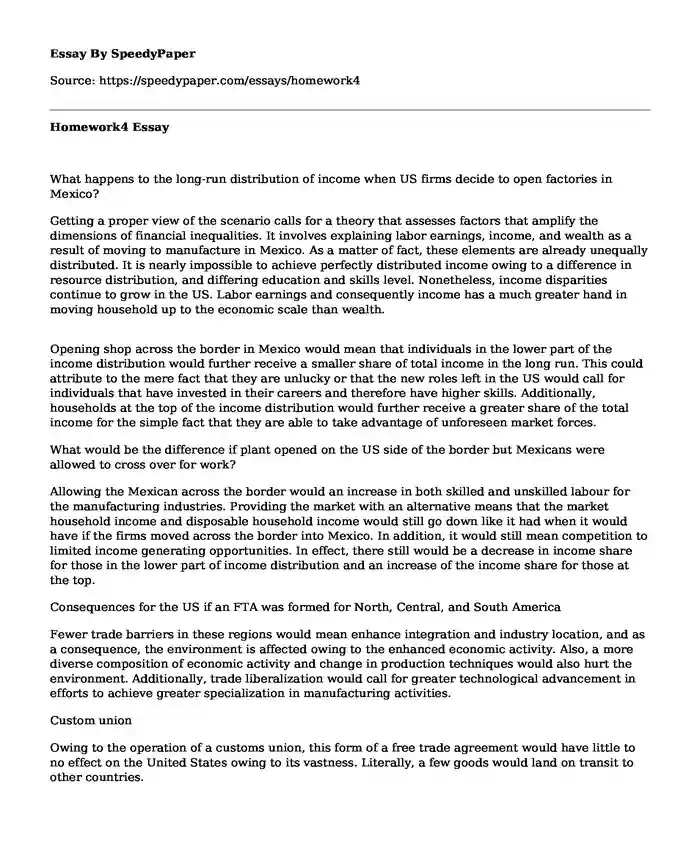
| Type of paper: | Problem solving |
| Categories: | Psychology Economics Analysis Personality Society |
| Pages: | 3 |
| Wordcount: | 556 words |
What happens to the long-run distribution of income when US firms decide to open factories in Mexico?
Getting a proper view of the scenario calls for a theory that assesses factors that amplify the dimensions of financial inequalities. It involves explaining labor earnings, income, and wealth as a result of moving to manufacture in Mexico. As a matter of fact, these elements are already unequally distributed. It is nearly impossible to achieve perfectly distributed income owing to a difference in resource distribution, and differing education and skills level. Nonetheless, income disparities continue to grow in the US. Labor earnings and consequently income has a much greater hand in moving household up to the economic scale than wealth.
Opening shop across the border in Mexico would mean that individuals in the lower part of the income distribution would further receive a smaller share of total income in the long run. This could attribute to the mere fact that they are unlucky or that the new roles left in the US would call for individuals that have invested in their careers and therefore have higher skills. Additionally, households at the top of the income distribution would further receive a greater share of the total income for the simple fact that they are able to take advantage of unforeseen market forces.
What would be the difference if plant opened on the US side of the border but Mexicans were allowed to cross over for work?
Allowing the Mexican across the border would an increase in both skilled and unskilled labour for the manufacturing industries. Providing the market with an alternative means that the market household income and disposable household income would still go down like it had when it would have if the firms moved across the border into Mexico. In addition, it would still mean competition to limited income generating opportunities. In effect, there still would be a decrease in income share for those in the lower part of income distribution and an increase of the income share for those at the top.
Consequences for the US if an FTA was formed for North, Central, and South America
Fewer trade barriers in these regions would mean enhance integration and industry location, and as a consequence, the environment is affected owing to the enhanced economic activity. Also, a more diverse composition of economic activity and change in production techniques would also hurt the environment. Additionally, trade liberalization would call for greater technological advancement in efforts to achieve greater specialization in manufacturing activities.
Custom union
Owing to the operation of a customs union, this form of a free trade agreement would have little to no effect on the United States owing to its vastness. Literally, a few goods would land on transit to other countries.
Common Market
First consequence would be the cost of legislation in order to adjust to a common rule across the regions. A single market would mean more regulations to the already existing federal and state ones. However, in benefits, the common market would bring with it increased trade. It could also divert trade from better and more efficient non-regional markets.
Monetary union
Inflation differentials will be persistent in the US alongside other member countries. Nonetheless, a common currency could contribute greater economic integration however, US strong economic linkages with the rest of the world would suffer a setback. The
Cite this page
Homework4. (2022, Dec 05). Retrieved from http://land-repo.site.supplies/essays/homework4?pname=speedypaper.com
Request Removal
If you are the original author of this essay and no longer wish to have it published on the SpeedyPaper website, please click below to request its removal:
- Philosophy Essay Example: The Socrates Method
- Essay Example on Downtown Dubai Hybrid Trolley System
- Juvenile Waiver Essay Example
- The United Nations was primarily formed as the successor to the League of Nations, which ended its operations after it was defeated in stopping World War II. During its creation, the U.N. began only with 51 member states, but today it is made up of 193 members and is headquartered in the New York City (Mingst & Karns, 2016). Significant initiatives run by the U.N. include providing humanitarian services to a large number of a population across the world, offering emergency food and medical assistance as well as solving conflicts by effective options to maintain peace. Besides, few years after its formation, a number of meetings were conducted where the main agenda was to draft a post-war charter that accurately outlined the most significant roles of the U.N. The membership rules were delineated on the permit where the membership was open to any peace-loving nation that accepted and was willing to undertake the responsibilities contained in the charter as well as the judgment of the organization (Assembly, 2010). The organization is typically structured into five principal organs which include the General assembly that is mainly concerned with the policy-making of the U.N., the Economic and Social Council that primarily concentrates on the environmental, social and economic issues associated with the development goals internationally. The third one is a judicial organ namely the international court of justice, which solves conflicts between members and offers advisory opinions to the organization (Mingst & Karns, 2016). The trustee council was also formed to ensure the self-governance of eleven territories, the UN Secretariat that acts as the administrative organ and lastly the Security Council, whose primary objective is to maintain international peace and security.
- Go Back to Where You Came From. Paper Example
- Essay Sample on Chinese Hot Pot
- Essay Exampl - Roles American Government Played During the New Deal
Popular categories




